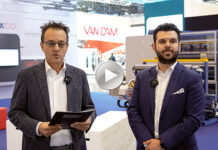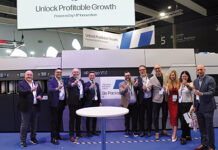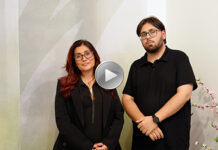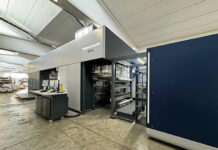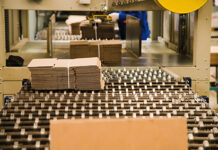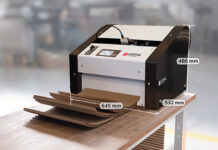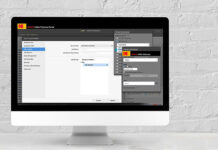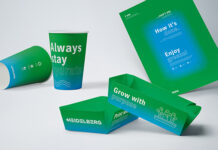The growth of RCL continues, the Piedmontese manufacturer of narrow web gravure printing machines serving niche applications for the pharmaceutical and wine industries, in particular for the printing of aluminum caps for bottles. Bruno Giorcelli, partner of the company with Gaetano Castellano, presents us with one of his latest innovations, a technology with an excellent quality/price ratio that can entice companies to invest to open up new markets
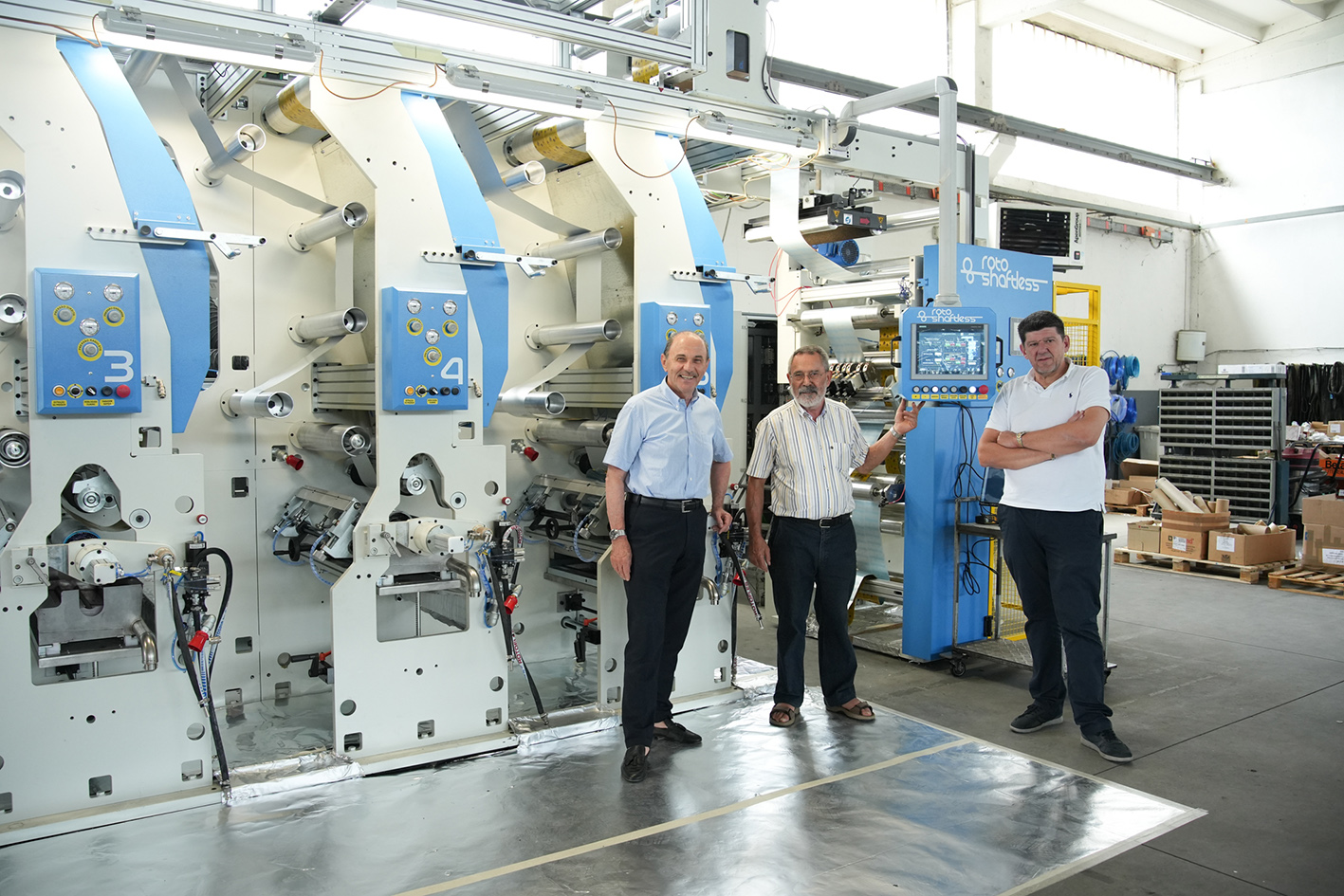
The packaging sector is always looking for innovations, both from a technological and application point of view, and RCL, which has always been a point of reference for the development of gravure printing technologies in narrow and even very narrow web, up to 160mm wide, it places itself on the market as a partner able to support its customers in the development of new projects, and why not also in the discovery of new markets.
We meet Bruno Giorcelli, at company’s headquarters in Terruggia in the province of Alessandria, in the heart of Monferrato, surrounded by splendid vineyards, which, as we will see later, have a lot to do with the business of some reference customers, Italian and foreign, of this Piedmontese manufacturer.
Rotoshaftless 5 colors for the Portuguese market
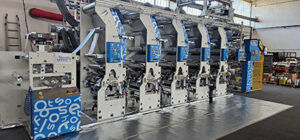 In the company’s workshop, which employs 20 people, a Rotoshafless with 5 gravure printing units, 4 colors + varnish, maximum web width of 550mm is being completed for a Portuguese customer who prints aluminum caps that cover the neck of bottles of wine. This is RCL’s top-of-the-range line which, as Bruno Giorcelli explains, supplies its machines with a series of innovative technical devices and solutions due to its construction philosophy, which certainly make the investment more onerous initially, but able to pay for itself in short time with high production efficiency and effective cost savings.
In the company’s workshop, which employs 20 people, a Rotoshafless with 5 gravure printing units, 4 colors + varnish, maximum web width of 550mm is being completed for a Portuguese customer who prints aluminum caps that cover the neck of bottles of wine. This is RCL’s top-of-the-range line which, as Bruno Giorcelli explains, supplies its machines with a series of innovative technical devices and solutions due to its construction philosophy, which certainly make the investment more onerous initially, but able to pay for itself in short time with high production efficiency and effective cost savings.
This model, which will soon be installed by a printer in Portugal, is not equipped with an automatic web change, which is obviously available, but only because for the short runs and the types of jobs printed it was considered sufficient to foresee a second axis for the second web, which allows the operator to prepare the next job which will then be managed manually by the operator. Thanks to this small expedient, however, a saving of 8-10 minutes is obtained in the job changeover. This small gravure machine, but only in size, because from a technological point of view it has nothing to envy to bigger lines, is managed entirely by electronics and each setting is saved and recorded to allow very fast start-up for future reprints. An intuitive and easy to use touch-screen interface allows to intervene in every part of the machine.
Gama G26 for in-line viscosity control
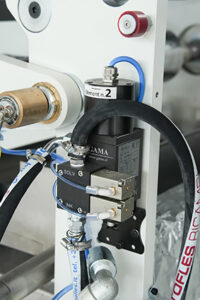 Among the various equipment that RCL has included as standard equipment on this line are Gama G26 viscometers, specially developed for solvent-based gravure printing. A partnership between Giorcelli and Sante Conselvan companies that has been going on for some years now with mutual satisfaction. As Bruno Giorcelli recalled at the beginning of our visit, RCL supplies the machine with all the auxiliary equipment deemed indispensable for a perfect and controlled printing process and the viscometer is certainly one of these key elements, also because the ink can when it is opened is subjected to temperature and humidity conditions and applying an ink without the correct viscosity can compromise the quality of the final work.
Among the various equipment that RCL has included as standard equipment on this line are Gama G26 viscometers, specially developed for solvent-based gravure printing. A partnership between Giorcelli and Sante Conselvan companies that has been going on for some years now with mutual satisfaction. As Bruno Giorcelli recalled at the beginning of our visit, RCL supplies the machine with all the auxiliary equipment deemed indispensable for a perfect and controlled printing process and the viscometer is certainly one of these key elements, also because the ink can when it is opened is subjected to temperature and humidity conditions and applying an ink without the correct viscosity can compromise the quality of the final work.
“Even in a compact machine like this, by virtue of the presence of large ink rests, the mere fact of keeping viscosity under control guarantees considerable savings. Furthermore, this printing machine is managed by a single operator, and being able to have an important level of automation throughout the entire printing process phase guarantees the quality of the final result with absolute control. The system is integrated into the machine, in each color unit, and we mounted a small touch-screen on the machine from which it is possible to manage the viscometers. If desired, in the future the solution can be integrated, if the customer feels the need, with the module for verifying ink consumption, useful for keeping costs under control but also for subsequent reprints, since having the data on real consumption, more precise estimates can be made”, intervenes Sante Conselvan of Gama, who is proposing a training course on the market on the automation of processes useful for achieving a higher level of standardization.
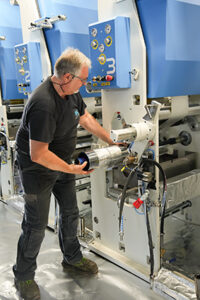
Thanks to the 5th color station you can apply the primer
“The time it takes to pass the material from the unwinder to the final winder and the machine is ready for production, with minimal material waste.The orders in this sector are mostly in 4 colors, but we have added the 5th color because thanks to the mobile diagonal bar, the customer can apply the primer on the raw material independently and inline or personalized writing can be inserted on the back of the material, and this is a recent need that has emerged in the wine sector, because writing is used as an anti-counterfeiting medium”, says Bruno Giorcelli.
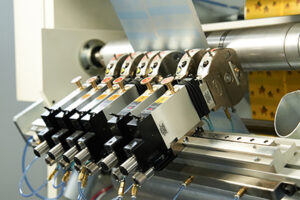 Again to meet the needs of printing of aluminum caps for wine bottles, where the graphics are often the same, but the color differs from customer to customer, RCL has decided to offer the change of color simply by removing the ink tray without touching the printing cylinders. It is important to underline that the cylinders that the customer has in his archive can be mounted on this model, and we know how important and valuable the cylinder heritage of every gravure printer is, because thanks to the adaptation cones inserted on the shaft, cylinders can be easily placed in the print element. At delivery, before the rewinder, the cutting phase is foreseen with knives and counter-knives which are mounted and fixed according to the final width of the web to be produced. This is an idea that was conceived by RCL precisely to be able to have a complete line from the virgin web to the final one, without the need for further off-line steps.
Again to meet the needs of printing of aluminum caps for wine bottles, where the graphics are often the same, but the color differs from customer to customer, RCL has decided to offer the change of color simply by removing the ink tray without touching the printing cylinders. It is important to underline that the cylinders that the customer has in his archive can be mounted on this model, and we know how important and valuable the cylinder heritage of every gravure printer is, because thanks to the adaptation cones inserted on the shaft, cylinders can be easily placed in the print element. At delivery, before the rewinder, the cutting phase is foreseen with knives and counter-knives which are mounted and fixed according to the final width of the web to be produced. This is an idea that was conceived by RCL precisely to be able to have a complete line from the virgin web to the final one, without the need for further off-line steps.
Drying hoods with independent temperatures
In the gravure printing process, the phase that is of the utmost importance is that of material drying, and on this model RCL has foreseen optimized hoods capable of offering two different levels of drying with different temperatures at entry and delivery which may differ +/- 30° also changing the air speed. This allows solids to be dried in the best possible way, because if solids are attacked immediately by an air flow, they risk drying out on the surface leaving the solvent still fluid in the underlying part.
Instead with this system the desired result is obtained at a printing speed of 120 meters per minute, which, as Giorcelli underlines, is an excellent result in this sector given that on average printing is done at no more than 50 meters per minute.
Rototestine 4 for printing very narrow webs
Rototestine is the latest RCL technology, born from an idea by Bruno Giorcelli, and in 4 years there are already 5 lines installed on the market. It is a 4-color horizontal zig-zag machine with 220 mm web width, equipped with winder, web guide, 2 floating drying hoods, camera, in-line cutting and final winding on two axes. The machine reaches a maximum speed of 120 meters per minute and produces very small webs, mainly with solids, but we have also seen multiple color webs (up to 7 with pantone and varnish) to produce disks that serve as a cover for the upper part of the cap, which are, with rare exceptions, printed with solids.
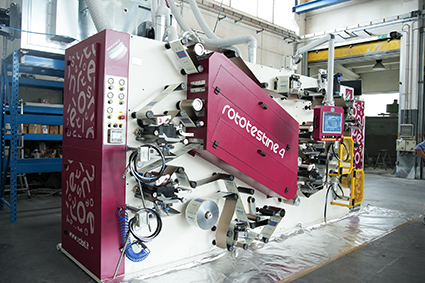
“This is a machine that I designed 4 years ago now: in the companies where it has been installed, where it is used for printing aluminum and PVC, it is proving to be a real success and works practically autonomously 24 hours a day, guaranteeing the production of all those small lots with high added value, which otherwise no one would be able to do. The investment is contained and allows the company to be able to penetrate new markets. I am also convinced that it could be the right technology for tapes sector but also for the world of labels. I have customers who had approached us for Rotoshaftless, but to whom I first proposed the Rototestine, betting with them that in a short time this investment would have repaid the largest Rotoshaftless, and so it was”, concludes Bruno Giorcelli who in the immediate future is betting a lot on this small but high-performing technology that will help many companies to diversify their offer.





